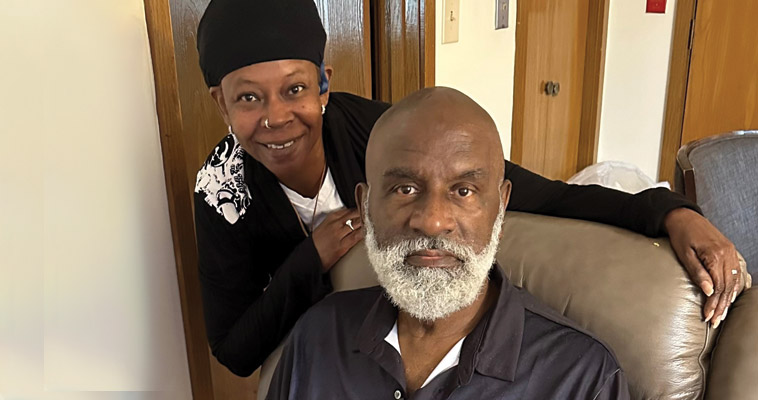
Photo credit: Sarah Driscoll
Jon’s Story
Jon has always been passionate about helping others. Throughout his life, he has always tried to give back what was given to him. Whether it was teaching locals kids how to carry themselves, how to have confidence, how to prepare for interviews, or teaching them home improvements skills, he always felt rewarded knowing he was making a difference. When he wasn’t inspiring the local youth, Jon worked several security jobs and also had a home improvement business on the side. In his free time, he would practice his ping pong skills, even participating in tournaments in Boston and New York.
On May 31st, 2023, Jon remembers telling a friend he felt off. Something wasn’t right. Soon afterwards, his left arm became numb, and he lost consciousness. That friend called 911, and Jon was quickly transported to the hospital for treatment of a stroke. When Jon awoke, he remembers being surrounded by tubes and medical equipment, things that would become familiar over the next 21 days that he spent in the ICU. Although he was happy to be alive, these days proved treacherous, as Jon could not speak or move much. Writing on a whiteboard became his only form of communication.
During Jon’s time at the hospital, a nurse pulled his sister and main supporter, Pam, aside to tell her about Money Follows the Person program. Because Jon was living with Pam prior to his stroke, she had a lot of concerns about what his life was going to be like and if he would be able to live independently again. After learning more about the program, she applied on Jon’s behalf and started working with a care manger, transition coordinator, and housing coordinator. They immediately began developing a plan that would eventually allow Jon to live in the community again.
After 9 more days in a step-down unit, Jon was ready to transition to a rehabilitation facility. He spent 25 days with a team of specialists learning how to talk, walk, and use his left hand again. He was extremely dedicated to his rehab, exercising at least 5, and sometimes 6, days a week. Jon was also doing exercises on his own, outside of time he spent with the therapy staff. As always, but especially during this time, Jon relied on his faith, praying to God every day and believing that God would allow him to recover fully.
Jon does not recall his time at the nursing home fondly. He remembers feeling like a nuisance to staff even though their job was to help him. Poor bedside manner and terrible food became his expectation. Pam recalls a specific time when Jon had a seizure and was sent to the hospital, and she did not find out until she called to speak with him the following day. During this time, Jon lost about 100 pounds because of the terrible food, and he continued to pray that he would become well enough to leave.
Like many people in the Money Follows the Person program, Jon’s team struggled to find appropriate housing for him. Eventually, it was Pam who knew someone that had a unit opening up, and this stroke of luck finally allowed Jon and his team to plan his discharge from the nursing home. The MFP team helped to provide some furniture, home goods, toiletries, kitchen essentials, and groceries for Jon upon moving in. They even helped move everything into the apartment, which Jon and his family are beyond grateful for. Jon was set up with a PCA, Connie, to help him with cleaning, laundry, grocery shopping, medication management, cooking, and more. He was quick to mention that Connie is a great cook, and he doesn’t take that for granted.
Pam did a lot of the back-and-forth communication with Jon’s MFP team. She expressed her immense gratitude towards them, recalling how much they cared about Jon as a person. The staff had passion for their jobs and therefore passion about giving Jon the best outcome they could. They were responsive, professional, and knowledgeable. Pam described how supported she felt throughout this process; the staff would remind her why she was doing this for Jon, and why it was worth all this work on top of her own life and full-time job responsibilities.
Now that Jon is happily living in the community again, he hopes his story will help and inspire others. He was not happy living in a facility, but now has the freedom to live life on his terms again. MFP has given him the opportunity to take back his health and independence, two things he takes very seriously. Jon till takes his recovery very seriously too, by staying active and eating healthily. He is once again enjoying home workouts, outdoor walks, going out to eat, and of course, ping pong.
Read the CT Money Follows the Person Quarterly Report (Link to full report)
MFP Demonstration Background
The Money Follows the Person Rebalancing Demonstration, created by Section 6071 of the Deficit Reduction Act of 2005, supports States’ efforts to “rebalance” their long-term support systems, so that individuals can choose where to live and receive services. One of the major objectives of Money Follows the Person (MFP) is “to increase the use of home and community based, rather than institutional, long-term care services.” MFP supports this by offering grantee States an enhanced Federal Medical Assistance Percentage on qualified services. MFP also offers states the flexibility to provide supplemental services, such as assistive technology and enhanced transition services, to assist in successful transitions. States are then expected to reinvest the savings over the cost of institutional services to rebalance their long-term services and supports for older adults and people with disabilities to a community-based orientation.
